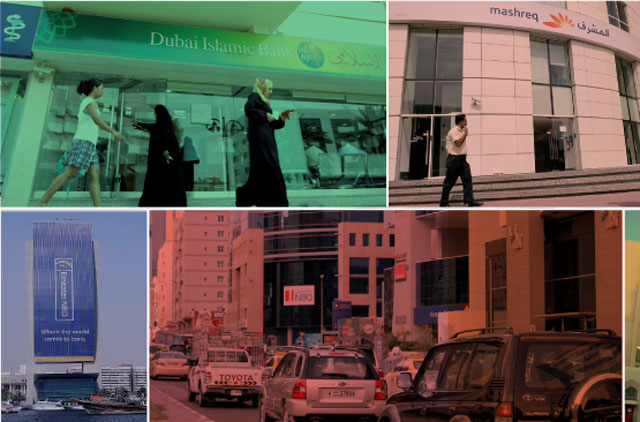
Dubai Idiosyncrasy. Apart from being a mouthful, this is not a term commonly taken up in any reference to the region's banking sector or the way it has been performing. But Anouar Hassoune, vice-president and senior credit officer at Moody's Paris office, does so and feels suitably justified in saying it.
In particular, he was referring to how regional banks seem better "insulated" from the ravages of the recession and its aftermath. Hassoune recently authored a report titled Arab Banks: Shielded Domestic Market Underpin Resilience to Crisis that underpins this sense of cautious optimism.
And this is what he had to say in the report: "The main reasons for the resilience of Arab banks to the crisis are (1) the capacity among both conventional and Islamic banks to adapt to macro-economic adversity; (2) their minimal exposures to subprime-related asset classes: (3) government support and sometimes intervention: as well as (4) local and regional idiosyncrasies."
All these came together in the banking sector putting in much better performance during the first three months of the year that was an improvement on even the more optimistic projections until then. Consequently, Moody's has extended a ‘stable' outlook on "most of the banking systems in the Arab world".
That these banking systems were insulated from the rest of the world's is cited by Moody's as the bedrock for the former's "stable creditworthiness during the turmoil". "This is because banks in this region had limited incentives to seek inflated returns abroad when domestic markets offered a far better risk-return trade-off," the report adds.
A closer look at the stream of data from the banking sector for the first three months of the year suggests the confidence is not misplaced. Of the GCC-based banks covered by Kuwait's Global Investment House, their combined profits in the first quarter was more than double over the previous quarter's, that is the last three months of 2009.
The Global report does record that the final tally easily beat analyst expectations in many instances. Net interest income of GCC banks grew a marginal 3 per cent on a year-on-year basis, pulled down by contraction in Kuwait and Saudi Arabia. Qatari banks were the standout performers with net interest income growing a stellar 19 per cent year-on-year.
Overall, aversion to risk was what the banking sector reflected. The Global report points to the "stagnancy" in net loans and the "dampened" growth in assets.
But the biggest turnaround came through in the lower provisioning levels. In fact, this was the catalyst in the significant earnings growth in the first quarter of 2010 against the fourth quarter of 2009.
Yet, while provisioning requirements were at their lowest in the first quarter compared with the three previous quarters, their levels of between 16 to 20 per cent continue to be high compared with the situation prior to the downturn.
Stable outlook
Looking forward, Moody's qualifies its stable outlook for the wider region's banking sector by maintaining a ‘negative' on those in the UAE, Bahrain and Kuwait.
"These three banking systems have been the most affected by the liquidity drought, the sharp fall in asset prices and the dramatic negative impact suffered by specialised institutions as a result of a concentrated, wholesale funding strategy and massive asset impairments," the report notes. "This is particularly evident in the UAE, where a sharp rise in credit delinquencies has incrementally weakened banks' profile."
All the more reason why the banking sector is particularly keen to know what the second quarter would throw up. Deepak Tolani, vice-president of equity research at Al Mal Capital, casts his concerns even further.
"We believe more is to come and spillover impact (is likely) into the first half of 2011," Tolani said. "UAE banks were over extended to the real estate and construction sectors - 20 to 30 per cent of loans books - and the economic downturn has in our opinion exposed just the surface weakness.
"Let's not forget local banks still need to account for the remaining 50 per cent of the Saad/Algosaibi exposure, take into account the impact of the restructured Dubai Holding loans and deal with weakened loan-loss coverage ratios."
Yes there have been plusses along the way such as the emerging clarity on Dubai World's exposure to the banking sector and how this will be recompensed. The stakeholders who are working towards a solution can lay claim to credit that is their due.
Yet, with the half-yearly results reporting season starting in a few weeks, "More than asset quality erosion I would keep an eye on the level of provisioning charges," Tolani added.
Provisions
"To a certain extent banks have control of which loans become non-performing via restructuring, but the provisioning will give an indication of what the banks see coming down the pipeline. Also, second quarter numbers may show provisions related to the restructuring at Dubai Holding."
If the medium-term prospects for UAE banks suggest a certain scepticism, Kuwaiti banks are living a nightmare. On a year-on-year basis, profits in its banking sector were down 9 per cent in the first quarter.
With the exception of National Bank of Kuwait, all the Kuwaiti banks covered by the Global report had made "significantly heavy provisions" during the period. There was nothing to cheer on the net interest income either, which was down 11 per cent from the levels recorded in the fourth quarter of 2009.
Saudi banks too felt the heat, with profits down 6 per cent year-on-year, while provisions were up a substantial 45 per cent for the same timeline.
"Net interest income has been on a declining trend for the last four quarters and continuation of the same does not bode well for the performance of the Saudi Arabian banking sector," the Global report issues an explicit warning.













